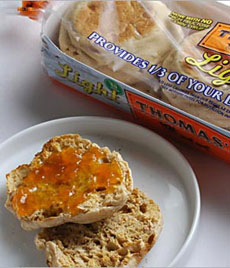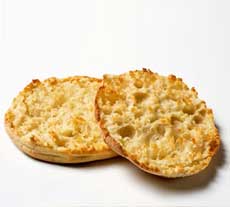
 The original Thomas’ English muffin is now made in more than 15 varieties, including flavors (Cinnamon, Honey Wheat, Cranberry), Light, Sourdough, Whole Wheat and Whole Grain. Photo courtesy S.B. Thomas.
The original Thomas’ English muffin is now made in more than 15 varieties, including flavors (Cinnamon, Honey Wheat, Cranberry), Light, Sourdough, Whole Wheat and Whole Grain. Photo courtesy S.B. Thomas.
KAREN HOCHMAN is Editorial Director of THE NIBBLE.
|
September 2010 |
 |
Thomas’ English Muffins
Page 2: How A Favorite Breakfast Treat Came To Be ... And To Be Called An “English Muffin”
This is Page 2 of an article on the history of English muffins, created by Samuel Bath Thomas, inventor of Thomas’ English Muffins. Click on the black links below to visit the other pages.
Who Invented The English Muffin? Samuel Bath Thomas!
No one denies that the English muffin was invented by Samuel Bath Thomas, a New York City resident who immigrated from Plymouth, England in 1874 and became a U.S. citizen. Thomas worked in a bread bakery, then opened his own bakery in 1880 at 163 Ninth Avenue between 19th and 20th Streets, in the neighborhood now known as Chelsea.
Ultimately, Thomas created a “toaster crumpet,” a version of the English crumpet that was both flatter and what is now called fork-split (crumpets, like muffins, are served whole). The recipe consisted mainly of flour, water, yeast and salt.
(The current ingredients are unbleached enriched wheat flour, water, farina, yeast, nonfat milk, high fructose corn syrup—yes, the processed food industry feels as if it must put HFCS or at least CS in everything—salt, soybean oil and preservatives.)
The trademark filing in 1926 stated that the name was first used in 1894; thus, we can use that as the year the English muffin debuted. |
|

See the resemblance of this English muffin to the crumpet on the previous page. Thomas’s technique preserved the “nooks and crannies.” Photo courtesy S.B. Thomas.
|
Thomas’ “toaster crumpet” preserved the nooks and crannies lost in knife-slicing and made it easier to toast. (Fork splitting is a thing of the past: Today in manufacturing, the muffins are run past wheels with Roman spear points that pierce the sides. “Nooks and crannies,” by the way, is a term popularized by a Thomas’s advertising campaign from the 1980s.)
Toaster crumpets caught on with Manhattan hoteliers as a tasty alternative to toast. Their popularity grew quickly, expanding to The Bronx and Queens. Thomas expanded to a second bakery around the corner at 337 West 20th Street. That building, now a co-op apartment residence, is known as “The Muffin Building,” and a 2006 basement renovation uncovered the 15' x 20' oven used by the bakery.
Thomas sold his product to consumers as well, and had been retailing his toaster crumpets through grocery stores long before the term “English muffin” was established (The Merriam-Webster Dictionary gives the origin of the term as 1902). The word “crumpet” has all but disappeared from American use, but English muffins have proved to be enduring.
How secret is the recipe? According to an article in The New York Times, only seven people know the trade secret that produces the nooks and crannies. And it isn’t easy to figure out: The article cites a baking industry consultant who “spent a good part of the 1980s and 1990s” trying to “break the code” for two competitors.
Other experts say that the basic technique is widely known: English muffin dough is very watery. When baked at a high heat, the water evaporates quickly and leaves large air pockets. Yet, nobody seems to have as many pockets as Thomas’.
Continue To Page 3: Wolferman’s English Muffins
Go To The Article Index Above
Lifestyle Direct, Inc. All rights reserved. Photos are the copyright of their respective owners.

|

